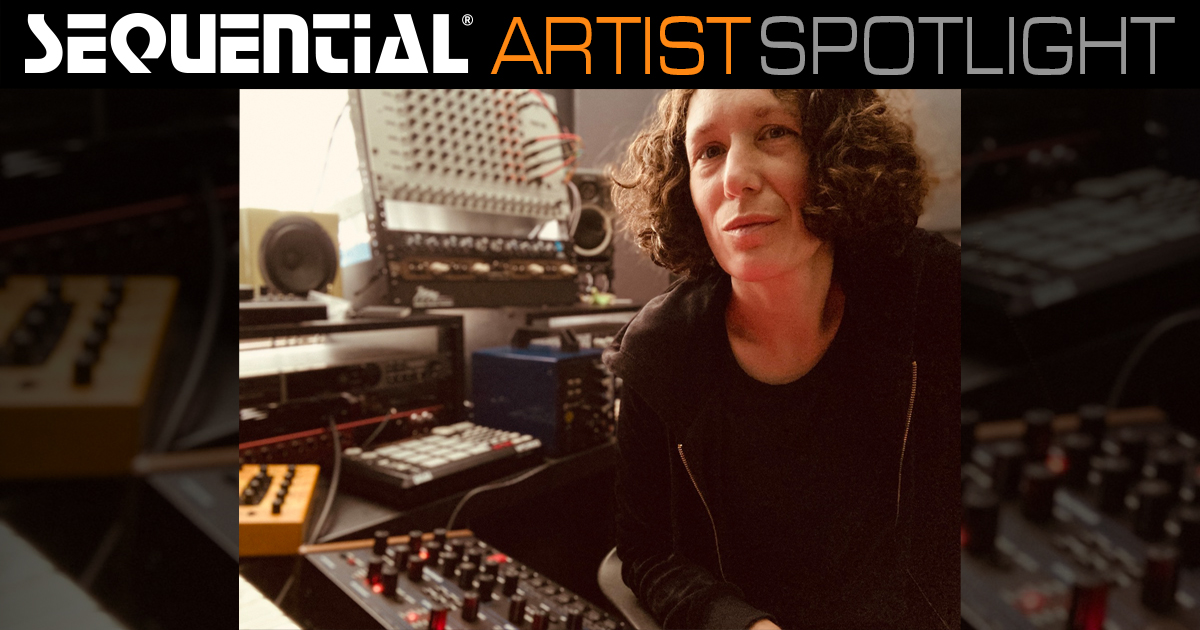
Dr. Tara Rodgers (Analog Tara) is a multi-instrumentalist composer and historian of electronic music. She is the author of Pink Noises: Women on Electronic Music and Sound (2010) and several essays on the history of sound and synthesizers. Her music includes recent techno EPs on 1432 R (DC), several self-released albums, remixes for Beauty Pill and Le Tigre, and a compilation release on Move D’s Source Records. She has presented music and public lectures at MUTEK, Ableton Loop, and many other forums.
We chatted with Analog Tara about how she uses Sequential instruments in her music:
What made you choose Sequential?
I work with a few instruments now in the DSI/Sequential family. My first was a DSI Mopho desktop, which I picked up around 2010 not long after it came out. At that time I was drawn to its size and power. I was putting together a compact analog techno setup for live performance and used an Akai MPC500 to sequence the Mopho and an MFB-522 drum machine. For minimal techno, electro, and acid house it was a big-sounding, fun, and very portable all-hardware combination.
In 2013, I bought a used Oberheim Matrix-1000. I was looking for an affordable way into the Oberheim sound world of Prince’s music and other synth music of that era, and this was it. These vintage synths have actually doubled or tripled in price since then, so I’m glad I acted when I did!
Both of these instruments became central to my studio – irreplaceable, really. And so when I learned about the Sequential OB-6 combining Dave Smith’s and Tom Oberheim’s design expertise, of course I was curious to work with it and in recent months have loved exploring what the OB-6 desktop can do.
How are you using it?
I produce a range of techno, ambient, and experimental music. For the beat-driven music, the Mopho and Matrix-1000 have held down most of the bass, lead and pad duties, respectively, for some years now. I’ve also used the Matrix-1000 extensively, sometimes exclusively, in ambient compositions. The OB-6 is a great addition because it has the vintage sounds and filters that I already love, but also the polyphony and the knob-per-function editability.
My typical process in the studio is to work up ideas with hardware first, sketching out ideas using the MPC500 to sequence synths and drum machines. I then track those loops into my laptop. The tracking stage can be labor intensive as I’ll often make certain creative choices in terms of sculpting the sound, or maybe doing some live filtering that becomes part of the recorded sound. Following that I’ll do extensive arranging and production inside Ableton Live in a way that elevates those analog sounds so that they shine and evolve even more.
What are some of your favorite things about them?
Mopho is spectacular as a bass unit. It remains my go-to for square or sawtooth bass. I don’t use many presets or have a need to create many – all I need is access to those pure wave shapes, maybe some sub boost, and the Curtis filter of course. Mopho bass really cuts through a mix without much EQ or processing and scales up well to a club sound system too. I’ve had people come up to me at shows and ask what’s kicking out that massive bass and it often comes a surprise when I point to this 5×7″ yellow box.
With the Matrix-1000, on the other end of the spectrum, there’s a certain magic in the high-frequency air space. In recent years I’ve been interested in creating music that has a vibrant presence, a kind of bold and sparkling quality – both in live performance settings and on recordings – and you get that instantly with the Matrix.
I started working the OB-6 recently and am excited to record entire projects with it. The music I make reflects my interests in the history of electronic music genres and instruments, and in refracting that history in new ways. The OB-6 to me is an instrument that does this in its design – it incorporates a lot of history while also being versatile and contemporary.
Any interesting tricks or techniques you would like to share?
Sure. For pads that I record from the OB-6 or Matrix-1000, I’ll often pair the rich analog sound source with digital processing in Ableton. For example, I’ll isolate a fragment of a gorgeous analog pad and transform it with delay and reverb effects in the digital realm. Some onboard processing is possible with the OB-6, but with digital audio editing you can hone in on particular parts of a sample and work with the frequency field in a more detailed way. It’s the best of both analog and digital worlds.
I also track through DIs and 500 series modules as much as I can, to maximize the sounds of the analog synths and really get inside their character when I record them. This feels like a key secret that I’m revealing here, but I love recording Oberheim synths through Harrison 32EQs. Maybe there’s something about the classic ’80s sound of both of these that makes them a perfect match. I have a 32EQ 500 series module but there’s good and cheaper software versions of it as well. For Mopho synth bass, I like the Rupert Neve Designs RNDI which allows that big sound to carry through.
You can listen to these instruments and techniques on the following releases:
Analog Tara / Dimensions (2021)
Analog Tara / Fundamentals (2018)
Analog Tara / Synthetic Fields (2020)
LINKS
MORE ABOUT SEQUENTIAL
For more information, check out the Sequential product page here.
Find your local dealer for pricing here.
If you’re using Sequential products in interesting ways, tell us about it. Contact us at .
